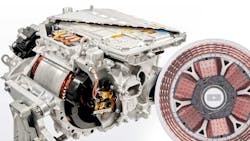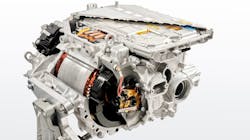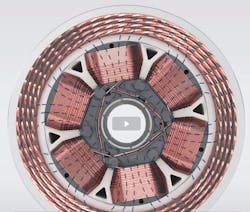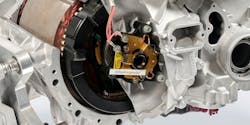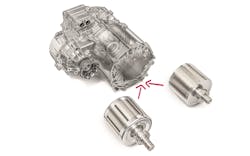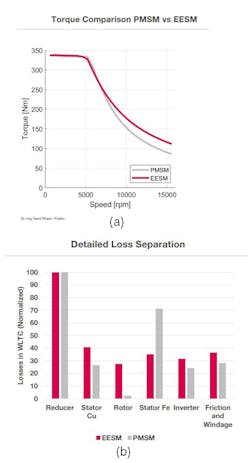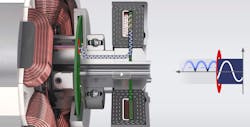New Motor Designs Help EV Makers Kick the Rare-Earth Habit (Part 1)
Members can download this article in PDF format.
What you’ll learn:
- Why EV manufacturers are working toward eliminating rare-earth materials from their motors.
- An introduction to the wound-rotor synchronous motor (WRSM) architecture, and some of its innovative implementations.
- How at least one manufacturer has eliminated the need for slip rings in its WRSM design.
At present, roughly 90% of the electric vehicles on the road are powered by permanent-magnet synchronous motors (PMSMs). All PMSMs rely on significant amounts of so-called rare-earth (RE) minerals to make them compact, practical, and powerful enough to compete with internal combustion engines. Although the unique properties of REs such as neodymium, terbium, and dysprosium have played an important role in the success of EVs, there’s a growing trend within the industry to reduce their use or eliminate them entirely.
The shift is being motivated in part by the rising costs of RE materials,1 but many manufacturers are also acutely aware of the environmental impacts associated with mining and refining them.2 Furthermore, European and North American manufacturers are concerned about the geopolitical impact of their dependence on REs that, at least for now, are primarily sourced from China, Africa, and other sensitive parts of the world.3
On top of that, PMSMs must be carefully protected against overheating, which can permanently de-magnetize the motor. It must also be protected against failure modes that could produce "uncontrolled generation" conditions, leading to deadly power surges being sent through the motor and its drive electronics.
As a result, many manufacturers are developing innovative magnet-free motor architectures. Many of these are new twists on the wound-rotor synchronous motor (WRSM), which replaces the PMSM's permanent magnets with electromagnet coils (Fig. 1).
Others are developing improvements on reluctance-type motors that derive their torque from the attraction between electromagnets in the stator and a magnetically soft iron or steel rotor. In Part 1, we’ll cover RE-free WRSMs; Part 2 will delve into inductive-type motors.
WRSM on the Rise
WRSM motors are very attractive to some manufacturers because they can be near-drop-in replacements for their currently used PMSM units (Fig. 2). And because the rotor's field strength can be electronically adjusted (something that can't be easily done with fixed-strength PMs), the control electronics required for four-quadrant traction applications (i.e., motoring and braking in forward and reverse) are relatively straightforward.
But this simplicity comes at a price. Barring significant innovations in its design, a motor based on the basic WRSM architecture will suffer from somewhat lower power density than a comparable PM motor. In addition, the WRSM's wound rotor can be more expensive to assemble. However, much of that is offset because the copper windings don’t need the costly RE minerals required in nearly all permanent-magnet-based rotors.
The other potential problem with WRSM technology is that it needs some way to deliver the power to energize its spinning rotor assembly, typically some sort of slip-ring assembly. Since slip rings and their associated brushes are susceptible to mechanical wear, they have the potential to introduce reliability problems—they slowly erode and introduce conductive particles into the area where the motor's high-voltage windings reside.
Some manufacturers have decided that WRSM's advantages outweigh the potential risks, and that they can overcome these issues. BMW, for example, applies slip rings to energize the rotor windings of its 5th-generation electric motor4 found in its iXM60 EV (Fig. 3).
The vehicle uses a pair of these slip-ring-energized WRSMs, with a 255-hp front motor and a 483-hp rear motor. The company says it’s confident that its brush assembly, housed in an enclosed and sealed compartment, will be very reliable and eliminate the potential for dust contamination inside the stator/rotor assembly.
Vitesco, a German drivetrain component manufacturer, has also adopted slip-ring technology to develop an alternative version of the permanent-magnet synchronous e-motor used in its EMR4 platform (Fig. 4). The original EMR4 platform is a scalable axle drive consisting of a PM synchronous machine, inverter, and reducer. Depending on the application's power requirements, the platform can now be used to build motors that use either PMSM or WRSM rotors of different lengths.
Both variants take advantage of Vitesco's unique "wave winding" process5 used to fabricate stators, providing a combination of excellent power density, efficiency, high-frequency operation, and cooling characteristics. Depending on the size of the WRSM rotor it’s built to drive, the power unit can produce between 80 and 230 kW.
When configured to run with a WRSM rotor, Vitesco's integrated drivetrain appears to overcome some of the shortcomings associated with PMSM motors. Most notably, it maintains almost constant power output as RPMs increase (Fig. 5a). On the other hand, it exhibits slightly higher mechanical and electrical losses than a comparable unit running with a brushless permanent-magnet rotor (Fig. 5b).
Some or all of these extra losses may be balanced out by the WRSM rotor's absence of magnetically induced drag, which PM motors exhibit during coasting. According to Vitesco, this reduction in drag lowers the drive’s power requirement by up to 5%, all without necessitating a mechanical decoupling device.
Giving WRSM the Brush-Off
For those who feel that the downsides of rotating connections are unacceptable, several companies are developing brush-free WRSM architectures. Mahle, a Stuttgart-based automotive component manufacturer, has demonstrated a pre-production WRSM drive unit that transmits power to the rotor inductively, using a pair of closely coupled coils (Fig. 6). The stationary transmitter coil, located in the motor body, emits an AC waveform that induces a current in the receiving coil, mounted on the rotor shaft, which is used to energize the rotating copper windings.
Martin Berger, Mahle’s head of research, said that the new motor incorporates the best attributes of several existing motor architectures, such as delivering good efficiency at both low and high torque levels. In addition, Berger says that the motor achieves at least 95% efficiency in typical EV use and tops 96% efficiency in some use cases.
According to an article published in IEEE Spectrum in May of 2021,6 Mahle said that samples are already being delivered and mass production is about two-and-a-half years away.
References
1. “4 Things You Should Know About Magnets for Electric Vehicles,” Maria Guerra, Electronic Design, Dec. 11, 2017.
2. “Rare earth mining may be key to our renewable energy future. But at what cost?,” Carolyn Gramling, Science News, Jan. 11, 2023.
3. “Top 10 Countries for Rare Earth Metal Production (Updated 2023),” Melissa Pistilli, Investing News, Apr. 19, 2023.
4. “No Magnets, Big Power: BMW’s Fifth-Generation Electric Motor,” Justin Banner, Motor Trend, Jan. 13, 2022.
5. “Process for Manufacturing Stator Wave Windings,” Dipl.-Ing. Astrid Haas, Dr.-Ing. Wilhelm Hackmann, Vitesco Technologies, 2022.
6. “In Mahle's Contact-Free Electric Motor, Power Reaches the Rotor Wirelessly: There's no wear and tear—and no rare earths, either,” Philip E. Ross, IEEE Spectrum, May 12, 2021.
About the Author
Lee Goldberg
Contributing Editor
Lee Goldberg is a self-identified “Recovering Engineer,” Maker/Hacker, Green-Tech Maven, Aviator, Gadfly, and Geek Dad. He spent the first 18 years of his career helping design microprocessors, embedded systems, renewable energy applications, and the occasional interplanetary spacecraft. After trading his ‘scope and soldering iron for a keyboard and a second career as a tech journalist, he’s spent the next two decades at several print and online engineering publications.
Lee’s current focus is power electronics, especially the technologies involved with energy efficiency, energy management, and renewable energy. This dovetails with his coverage of sustainable technologies and various environmental and social issues within the engineering community that he began in 1996. Lee also covers 3D printers, open-source hardware, and other Maker/Hacker technologies.
Lee holds a BSEE in Electrical Engineering from Thomas Edison College, and participated in a colloquium on technology, society, and the environment at Goddard College’s Institute for Social Ecology. His book, “Green Electronics/Green Bottom Line - A Commonsense Guide To Environmentally Responsible Engineering and Management,” was published by Newnes Press.
Lee, his wife Catherine, and his daughter Anwyn currently reside in the outskirts of Princeton N.J., where they masquerade as a typical suburban family.
Lee also writes the regular PowerBites series.
